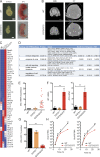RNase H2 catalytic core Aicardi-Goutières syndrome-related mutant invokes cGAS-STING innate immune-sensing pathway in mice
- PMID: 26880576
- PMCID: PMC4813680
- DOI: 10.1084/jem.20151464
RNase H2 catalytic core Aicardi-Goutières syndrome-related mutant invokes cGAS-STING innate immune-sensing pathway in mice
Abstract
The neuroinflammatory autoimmune disease Aicardi-Goutières syndrome (AGS) develops from mutations in genes encoding several nucleotide-processing proteins, including RNase H2. Defective RNase H2 may induce accumulation of self-nucleic acid species that trigger chronic type I interferon and inflammatory responses, leading to AGS pathology. We created a knock-in mouse model with an RNase H2 AGS mutation in a highly conserved residue of the catalytic subunit, Rnaseh2a(G37S/G37S) (G37S), to understand disease pathology. G37S homozygotes are perinatal lethal, in contrast to the early embryonic lethality previously reported for Rnaseh2b- or Rnaseh2c-null mice. Importantly, we found that the G37S mutation led to increased expression of interferon-stimulated genes dependent on the cGAS-STING signaling pathway. Ablation of STING in the G37S mice results in partial rescue of the perinatal lethality, with viable mice exhibiting white spotting on their ventral surface. We believe that the G37S knock-in mouse provides an excellent animal model for studying RNASEH2-associated autoimmune diseases.
© 2016 Pokatayev et al.
Figures



Similar articles
-
Ribonuclease H2 mutations induce a cGAS/STING-dependent innate immune response.EMBO J. 2016 Apr 15;35(8):831-44. doi: 10.15252/embj.201593339. Epub 2016 Feb 22. EMBO J. 2016. PMID: 26903602 Free PMC article.
-
Characterization of six recombinant human RNase H2 bearing Aicardi-Goutiéres syndrome causing mutations.J Biochem. 2019 Dec 1;166(6):537-545. doi: 10.1093/jb/mvz073. J Biochem. 2019. PMID: 31529068 Free PMC article.
-
Cutting Edge: cGAS Is Required for Lethal Autoimmune Disease in the Trex1-Deficient Mouse Model of Aicardi-Goutières Syndrome.J Immunol. 2015 Sep 1;195(5):1939-43. doi: 10.4049/jimmunol.1500969. Epub 2015 Jul 29. J Immunol. 2015. PMID: 26223655 Free PMC article.
-
Aicardi-Goutières syndrome: clues from the RNase H2 knock-out mouse.J Mol Med (Berl). 2013 Nov;91(11):1235-40. doi: 10.1007/s00109-013-1061-x. Epub 2013 Jun 7. J Mol Med (Berl). 2013. PMID: 23744109 Review.
-
Is the role of human RNase H2 restricted to its enzyme activity?Prog Biophys Mol Biol. 2016 May;121(1):66-73. doi: 10.1016/j.pbiomolbio.2015.11.001. Epub 2015 Nov 19. Prog Biophys Mol Biol. 2016. PMID: 26603688 Review.
Cited by
-
The cGAS-STING pathway as a therapeutic target in inflammatory diseases.Nat Rev Immunol. 2021 Sep;21(9):548-569. doi: 10.1038/s41577-021-00524-z. Epub 2021 Apr 8. Nat Rev Immunol. 2021. PMID: 33833439 Free PMC article. Review.
-
Old dogs, new trick: classic cancer therapies activate cGAS.Cell Res. 2020 Aug;30(8):639-648. doi: 10.1038/s41422-020-0346-1. Epub 2020 Jun 15. Cell Res. 2020. PMID: 32541866 Free PMC article. Review.
-
Loss of Mitochondrial Protease CLPP Activates Type I IFN Responses through the Mitochondrial DNA-cGAS-STING Signaling Axis.J Immunol. 2021 Apr 15;206(8):1890-1900. doi: 10.4049/jimmunol.2001016. Epub 2021 Mar 17. J Immunol. 2021. PMID: 33731338 Free PMC article.
-
Prognostic Value of RNASEH2A-, CDK1-, and CD151-Related Pathway Gene Profiling for Kidney Cancers.Int J Mol Sci. 2018 May 28;19(6):1586. doi: 10.3390/ijms19061586. Int J Mol Sci. 2018. PMID: 29843367 Free PMC article.
-
The Regulation of cGAS.Virol Sin. 2018 Apr;33(2):117-124. doi: 10.1007/s12250-018-0005-6. Epub 2018 Mar 15. Virol Sin. 2018. PMID: 29546673 Free PMC article. Review.
References
-
- Chon H., Vassilev A., DePamphilis M.L., Zhao Y., Zhang J., Burgers P.M., Crouch R.J., and Cerritelli S.M.. 2009. Contributions of the two accessory subunits, RNASEH2B and RNASEH2C, to the activity and properties of the human RNase H2 complex. Nucleic Acids Res. 37:96–110. 10.1093/nar/gkn913 - DOI - PMC - PubMed
Publication types
MeSH terms
Substances
Supplementary concepts
Grants and funding
LinkOut - more resources
Full Text Sources
Other Literature Sources
Medical
Molecular Biology Databases
Research Materials

